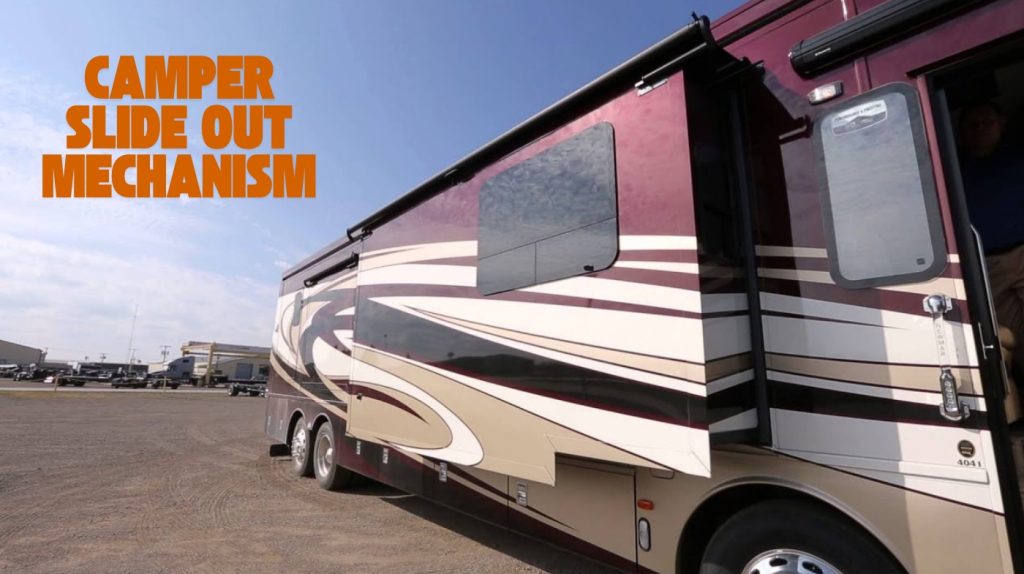Last Updated on August 17, 2025
You’ll find camper slide out mechanisms mostly fall into electric, hydraulic, cable-driven, or rack and pinion types. Electric systems use motors and gear reductions for efficient, controlled extension, while hydraulics rely on fluid power for heavy loads and smooth operation.
Cable drives offer space-saving benefits for larger slides, and rack and pinion systems provide flush-floor designs with durable mechanical engagement. Each has unique maintenance and installation demands, so understanding their strengths helps you choose the best fit for your camper’s size and use.
Exploring their functions further reveals important considerations.
Key Takeaways
- Camper slide out mechanisms include electric (rack and pinion, cable, Schwintek) and hydraulic systems for extending/retracting living space.
- Electric rack and pinion systems use worm gears and motors for floor-flush slides, requiring regular lubrication and electrical maintenance.
- Cable-driven systems utilize steel cables and pulleys, ideal for heavy or deep slides but need tension adjustments and cable inspections.
- Hydraulic slide outs employ pumps and cylinders for smooth, quiet operation, handling loads up to 1,500 pounds with fluid level maintenance.
- Selection depends on slide size, load capacity, space constraints, maintenance preferences, and cost considerations.
Types of Camper Slide Out Mechanisms
When choosing a camper slide out mechanism, you’ll find several distinct types, each engineered for specific load capacities, installation constraints, and operational characteristics.
The rack and pinion system, known for reliability and affordability, uses electric motors with worm gears to drive rack teeth, enabling a flush-floor slide with minimal maintenance. This type of mechanism, however, requires ongoing upkeep to prevent potential mechanical issues.
Cable systems employ pulleys and cables to handle heavy, deep slides efficiently, though they reduce interior ceiling height and come at a higher cost. Schwintek mechanisms, using worm gears on rails, suit light loads but lack flush-floor capability and are prone to failure if misapplied.
Happy Jack, less common now, fits shallow slides with a unique self-contained control. SlimRack, a modern variant, mounts racks only at slide ends to reduce friction, offering an alternative to Schwintek with detailed maintenance support.
Electric Slide Out Systems
You’ll find electric slide out systems depend on motor-driven mechanisms like rack and pinion or cable drives to extend and retract slides efficiently. These systems often require components that can handle high load to ensure smooth operation under stress.
Operating these systems requires a fully charged battery and careful adjustment of stops to maintain proper sealing and prevent motor overload. Regular maintenance, including lubrication and cautious manual override use, guarantees reliable function and safeguards against gear damage.
Additionally, choosing the right type of electric motor-driven slide mechanism can help minimize common issues such as overload and gear failure.
Motor Types Explained
Although electric slide out motors vary in design and application, they fundamentally serve to power mechanisms such as rack and pinion, cable, Schwintek, and power gear systems in RV slide outs. You’ll find motors typically run at 12V DC, with gear ratios like 18:1 or 28:1 to optimize torque and speed.
High RPM motors (up to 5,800 RPM) paired with gear reduction balance slide speed and force. Manufacturers like Lippert and Power Gear supply durable motors tailored for specific drive types, including compact designs for cable systems such as Accu-Slide™.
Proper maintenance and lubrication are essential to ensure long-lasting motor performance. Electric motor driven slides are commonly used on smaller, lighter slides and are valued for being cost-effective and less complex compared to hydraulic systems.
Operation and Maintenance
Since electric slide-out systems rely heavily on consistent power delivery, maintaining a stable 12-volt supply is essential for reliable operation and to prevent motor damage. You should regularly monitor battery voltage and ensure shore power connections remain intact to avoid low-voltage faults that can inhibit slide movement or trigger error codes.
Proper maintenance and care of electrical components extends the system’s lifespan. Most electric slide-outs use an actuator motor powered by this 12V supply to extend and retract smoothly.
Operate the three-way control switch carefully, and avoid forcing the mechanism. Periodically inspect mechanical components—gears, cables, drive shafts—for wear or lubrication needs. Programming slide stops precisely is critical to prevent misalignment and mechanical stress. Use stabilizing jacks when extended to prevent sagging.
Electrical connection integrity and fuse conditions also require regular checks. By adhering to these technical maintenance protocols, you guarantee smooth, synchronized extension and retraction, prolonging motor lifespan and maintaining operational safety.
Hydraulic Slide Out Systems
When you engage a hydraulic slide out system, a coordinated set of components—including a pump, fluid reservoir, hydraulic lines, and cylinders—work together to extend or retract the slide with controlled fluid pressure.
The electrically powered pump pressurizes hydraulic fluid, directing it through lines to either side of the piston shaft inside the hydraulic cylinder. This piston shaft transfers mechanical force, smoothly pushing the slide room outward or retracting it with precise control.
Valves and solenoids regulate fluid flow, ensuring consistent force application and reducing mechanical wear compared to electric systems. These systems require regular fluid checks and leak inspections to maintain optimal functionality.
Hydraulic slides handle loads up to 1,500 pounds efficiently, delivering robust, quiet operation even under variable conditions. Regular inspection of fluid levels, lines, and solenoids is critical to prevent leaks and maintain performance.
Cable Driven Slide Mechanisms
You’ll find cable-driven slide mechanisms use steel cables connected to an electric motor that controls slide extension and retraction with synchronized tension. These systems rely on proper wiring and cable tension to prevent misalignment or damage during operation.
Maintaining proper cable tension and monitoring motor controller indicators are critical to avoid operational failures. Using components with vibration resistance can enhance system durability in rugged conditions. These systems offer compact, lightweight designs ideal for heavy, large slide-outs but require regular inspection to manage cable wear and electrical issues.
Cable System Design
How do cable-driven slide mechanisms efficiently extend and retract camper slide-outs? They use steel cables arranged at the four corners, routed via pulleys and guides, including sharp 90-degree turns, to convert rotational motor power into linear slide movement. The cables are often made from corrosion-resistant materials to ensure durability even in harsh outdoor conditions.
A 12V electric actuator motor winds and unwinds these cables, positioned above the floor line to avoid underbelly intrusion. The cables support heavy slide-outs and work with slide rails and mounting brackets to maintain stability. This system is typically suitable for small slides, as larger slides may experience sag or failure risks due to cable stretch.
This design is lightweight, preserves underchassis space, and protects components from weather. Dual-cable variations optimize force distribution. However, cable stretch and slight interior intrusion are limitations. Regular inspection guarantees pulley alignment and motor function. Proper maintenance and use of durable materials also help prolong system reliability.
Operation and Maintenance
Cable-driven slide mechanisms rely on a coordinated system of steel cables, pulleys, and a 12V actuator motor to extend and retract camper slide-outs smoothly and reliably. Proper identification and compliance with vehicle regulations ensure safe operation on public roads.
You control the slide movement with a three-way wall switch, while manual override is possible by turning the motor with a compatible tool inside the slide compartment. The slide motor is typically located centrally on the slide inside the RV, often behind a flange that may need to be removed for access.
For maintenance, regularly inspect cables and pulleys for wear or misalignment to prevent premature failure. Apply lubrication to reduce friction and check motor mounts and gearbox tightness to ensure consistent power transfer.
Address cable tension evenly to avoid binding or erratic movement. Always disconnect power before maintenance, keep components free of debris, and avoid forcing the slide to prevent mechanical damage.
Advantages and Challenges
Although cable slide mechanisms offer significant advantages in weight reduction and space efficiency, they also present design and maintenance challenges you need to contemplate. Their above-floor placement reduces chassis intrusion, improving cargo capacity and protecting components from debris and weather, consequently enhancing durability.
This system uses cables, pulleys, and an electric motor to extend and retract the slide, making it suitable for longer and heavier slides. Proper maintenance, including regular inspections and adjustments, is crucial to maximize the system’s lifespan and performance, similar to recommended RV tire maintenance practices.
However, this design intrudes slightly into interior living space, creating ergonomic and layout constraints, including trip hazards and limited floor customization. Mechanically, cable stretch demands periodic adjustment, and early models had reliability issues such as oil leaks and labor-intensive manual overrides.
Despite these concerns, the streamlined, lighter system supports smooth, motorized operation for long slides and remains cost-effective compared to rack and pinion systems. You must weigh these trade-offs carefully to ensure performance, longevity, and user comfort align with your RV’s design goals.
Rack and Pinion Slide Systems
What makes rack and pinion slide systems a preferred choice for many RV slide-outs lies in their robust mechanical design and efficient operation.
You’ll find a large ram bar attached to the slide-out passing through the chassis frame rail, driven by an electric motor with a pinion gear engaging teeth on a rack mounted along the frame. This “electric through-frame” setup minimizes interior interference and supports a floor-flush slide-out design.
Many RV owners complement this setup with electric start features for easier operation. The slight downward roof angle aids water runoff, reducing leaks and ice dam risks. Maintenance involves regular lubrication and cleaning of gear teeth to prevent wear and operation issues.
While heavier and less flexible in placement, this system excels in durability and handles heavy slide-outs smoothly, offering reliable, low-maintenance performance ideal for larger RV living spaces. One notable drawback is that punching through the frame rail may create access points for pests like mice.
Specialized Slide Systems Like Schwintek
When you operate a Schwintek slide system, you engage independent electric motors—typically one on each side—that synchronize via a dedicated electronic controller to guarantee smooth, aligned movement.
This controller manages power from the RV system and uses a push-button interface, where holding the button 4–5 seconds post-travel triggers “zeroing” to maintain motor alignment. The system operates on 12V power supplied by the RV’s battery, making battery charge and voltage levels critical for proper operation.
Proper maintenance and regular inspections help prevent common issues such as motor stalls and misalignment.
The motors drive the slide along multi-rail metal tracks, usually four rails, with six on larger slides for added support. Schwintek excels in lighter to medium-weight applications but can suffer motor stalls, grinding, and misalignment due to synchronization loss or mechanical wear.
Troubleshooting focuses on electrical connections, controller diagnostics, and track alignment. Emerging competitors like Sure Slide address Schwintek’s twisting and jamming issues via redesigned locking mechanisms and improved motor access, enhancing reliability and serviceability. These improvements echo the importance of durability and maintenance observed in other specialized mechanical systems.
Historical Development of Slide Outs
Understanding the sophisticated mechanisms behind modern slide-outs, like the Schwintek system, benefits from examining their origins. Slide-outs date back to the 1920s with manual rack-and-pinion extensions on trailers, evolving through military applications in WWII that doubled usable space without automation.
Regular maintenance, including sealing and staining, is essential to preserve wooden components exposed to weather. The commercial RV industry adopted manual slide-outs in the 1980s before shifting to powered systems in the 1990s.
Key historical points include:
- Early manual designs prioritized simple mechanical extensions, lacking motorized control.
- WWII military trailers demonstrated practical expandability, influencing civilian designs.
- The 1990s introduced electric and hydraulic drives, enhancing reliability and ease of use.
These advancements led to the development of complex motorized systems operable by a button or lever, significantly improving RV comfort and convenience for enthusiasts. Applying a protective sealant on wooden parts of slide-out mechanisms extends their lifespan and maintains their appearance.
Factors Influencing Slide Out Mechanism Selection
Although selecting the appropriate slide out mechanism depends on multiple variables, you must prioritize factors such as size, weight capacity, operation type, reliability, maintenance demands, and cost.
Larger slide outs require hydraulic systems for their superior weight handling, whereas electric mechanisms suit moderate sizes with simpler installation and quieter operation. Hydraulic slide-outs are also known for their power and reliability, making them ideal for bigger RV models.
Cable-driven options fit smaller, budget-conscious designs but have weight limitations. You should consider durability: hydraulics need fluid and seal upkeep, electric motors require lubrication, and cables demand regular inspection due to multiple moving parts.
Maintenance complexity varies; hydraulic systems involve fluid checks, electric and cable systems need motor and cable inspections. Cost-wise, hydraulics are pricier upfront, electric strike a balance, and cable systems are economical. Finally, installation space and environmental exposure influence mechanism longevity and performance.
Frequently Asked Questions
How Do I Troubleshoot a Slide Out That Won’t Extend or Retract?
Start by checking your RV battery and fuses to guarantee proper power supply. Inspect wiring for damage or loose connections. Test the slide-out motor for functionality using a voltmeter or direct power. Examine tracks and gears for debris or misalignment, cleaning and lubricating as needed.
If stuck, try fully extending or retracting using the manual override cautiously. Follow manufacturer guidelines to avoid damage and synchronize dual motors if the slide moves unevenly.
What Maintenance Is Required to Keep Slide Outs Operating Smoothly?
You should regularly clean and inspect seals, roof sweeps, and mechanical components for wear, debris, or damage. Lubricate rubber seals twice yearly with dry lubricant, avoiding oil-based types.
Clean mechanical parts and apply rust protection, using manufacturer-approved lubricants. Test manual overrides periodically. Keep slide-outs retracted when not in use to prevent environmental damage. Promptly address any irregularities or damage to guarantee reliable, smooth operation and extend component lifespan.
Can Slide Outs Be Operated Manually During a Power Failure?
When the power takes an unexpected break, you can still manually operate your slide outs. Most RVs include a manual override—usually a crank handle stored nearby to retract slides safely.
First, disconnect the battery to protect your motor, then engage the crank carefully, following your model’s instructions. Avoid forcing the mechanism beyond its limits to prevent damage. This fail-safe guarantees you maintain control even without electrical power.
How Do Weather Conditions Affect Slide Out Performance and Durability?
Weather conditions directly impact your slide-out’s performance and durability. Extreme temperatures cause rubber seals to harden or crack, compromising seals and increasing friction. Moisture promotes corrosion and mold, while freezing water risks mechanical jamming.
Wind stress can misalign components, accelerating wear. UV exposure degrades seals and lubricants, raising friction and wear rates. To maintain ideal function, regularly inspect seals, lubricate moving parts, and retract slides during severe weather and sun exposure.
Are There Safety Precautions When Using or Repairing Slide-Out Mechanisms?
Imagine a heavy metal arm sliding smoothly but powerfully now, never stand close or force it if it resists. You should level your RV, check battery charge, and clear the area before use. When repairing, inspect mounts, lubricate parts, and remove debris carefully.
Always disengage travel locks and use manual overrides if needed. These steps reduce injury risks and mechanical failures, ensuring safe, reliable slide-out operation.
Transform Your RV Experience with the Right Slide Mechanism
When choosing a camper slide-out mechanism, you need to weigh reliability, maintenance, and power needs carefully. For instance, imagine relying on an electric system during a remote trip; any failure could trap you in a cramped space, turning convenience into frustration.
By understanding options like hydraulic or cable-driven systems, you can select the best fit for your travel style and environment, ensuring smooth operation and lasting performance throughout your adventures.



